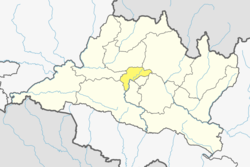Gongabu गोङ्गबु | |
|---|---|
Village of Tokha Municipality | |
| Coordinates: 27°45′N85°19′E / 27.75°N 85.32°E | |
| Country | |
| Province | Bagmati Province |
| District | Kathmandu District |
| Population (2011) | |
• Total | 54,410 |
| Time zone | UTC+5:45 (Nepal Time) |
Gongabu is a village and former Village Development Committee that is now part of Tokha Municipality in Kathmandu District in Bagmati Province of central Nepal. At the time of the 2011 Nepal census it had a population of 54,410 and had 14,456 households in it in an area just 270 hectares in size. [1]


